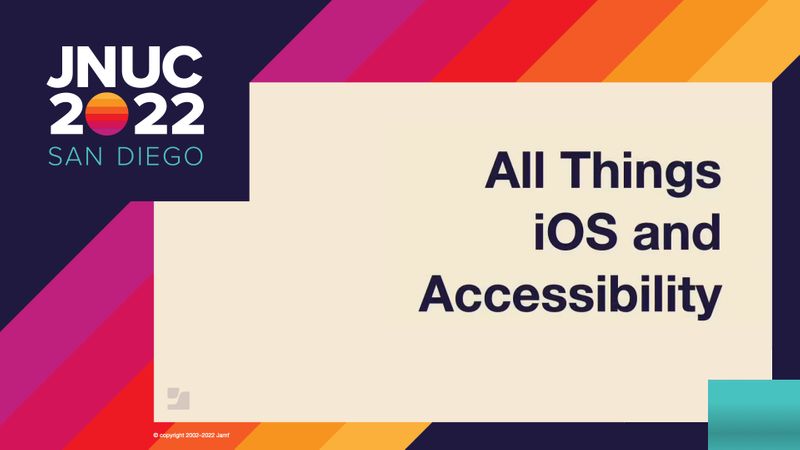Presenters
This session, which featured ASL interpretation, was run by people with a great deal of personal and professional experience in disability accommodation.
This joint presentation featured:
- Don Mueller, Technical Enablement Manager II, Jamf
- Kelly Offerman, Senior Business Development Executive, Healthcare, Jamf
- Hector Ibarraran, Field Sales Engineer II, Jamf
- Tim Kilburn, Technology Consultant, Fort McMurray Catholic Schools, Alberta, Canada
Disability statistics
- 26% of adults in the United States have some type of disability
- More than 253 million people worldwide are blind or visually impaired, 36 million of whom are totally blind
- Dyslexia affects anywhere from 10-17% of the population
- Approximately 20% of the population is affected by hearing loss
- Around two million people in the US have limb differences
Aim of the presentation
“Our hope today,” said Tim Kilburn, “is that you will consider the needs and feelings of persons with various disabilities in your interactions, in your presentations, in your employment opportunities and more.”
Personal experiences
Tim Kilburn
Kilburn, who is blind, explained that blindness or vision impairment covers a range of visual experiences, from a total loss of sight to some sight that isn’t fully correctable.
Kilburn has a few advantages over sighted people due to his blindness, including superior proofreading skills: Using Apple’s built-in screenreader VoiceOver, he hears errors that people who are sighted can scan over and miss. “Listening,” says Kilburn, “actually does a better job of proofreading than simply viewing.”
Kelly Offerman
Offerman has dyslexia: a difference in the way one processes information that affects the ability to process language — particularly decoding phonics. While dyslexia is not related to intelligence, the concentration that reading requires can affect comprehension.
Offerman explained some of the unique advantages people with dyslexia often have in accessing certain types of reasoning, including interconnective reasoning. She also outlined how iOS accessibility tools have benefitted her professionally.
Don Mueller
Mueller discussed his experience with severe-to-profound hearing loss in both ears. The need to really focus carefully on information has helped Mueller hone his attention to detail, he says, and Apple accessibility features have helped him to join in on family and work activities.
Hector Ibarraran
Ibarraran discussed his experience with a limb difference, which can be a partial or complete absence of a limb. His particular difference, which is congenital, affects his ability to do actions like pinching motions on screens. The release of Apple Watch was, to Ibarraran, a revelation.
iOS accessibility tools (and one macOS)
- VoiceOver: Kilburn ran attendees through a demonstration of using this feature with his iPhone so that he can hear what is on the screen where he touches it.
- Sidecar: while not generally considered an accessibility tool, Sidecar helps Offerman to see a side-by-side reference of content to ensure accuracy.
- HomePod Mini: also not considered an accessibility tool, HomePod Mini helps Offerman to request spelling from Siri and hear it loudly and clearly. Mueller uses it to show the lyrics to music that is playing.
- Sound Recognition: iPhone’s Sound Recognition feature can pick up on a knocking door and other sounds and offer visual and vibration notifications based on sound.
- Apple Watch: because it only requires one point of contact to move through its features, and because it is so easy to put on, Ibarraran can use it with no difficulty.
- Text-to-speech: Offerman demonstrated how she uses the text-to-speech feature on her Mac to write and to listen to text on-screen.
How Jamf helps users find Apple accessibility features
Apple’s accessibility features are so numerous —and are being improved and expanded upon so often— that it can be easy for users to lose track of how to use them. Apple shortcuts can help guide users to the features that will help them.
Enter Jamf’s Self Service: a way to distribute Apple’s accessibility shortcuts to anyone in your organization who wants information on accessibility.
Ibarraran explained how Self Service can offer accessibility shortcuts to end-users on an iPad, and some benefits.
Chiefly, users who do not wish to disclose a disability can get access to accommodations on their own, and those who aren’t clear on what they might need as accommodation can find native features that may help them based on impairment or challenge.
Mueller offered a tutorial on how Jamf admins can install this feature into Self Service.
by Category:
Have market trends, Apple updates and Jamf news delivered directly to your inbox.
To learn more about how we collect, use, disclose, transfer, and store your information, please visit our Privacy Policy.



